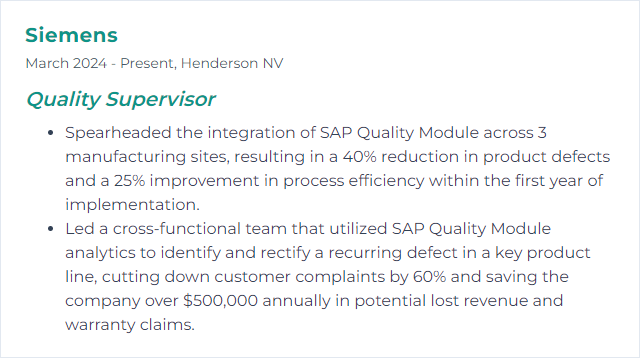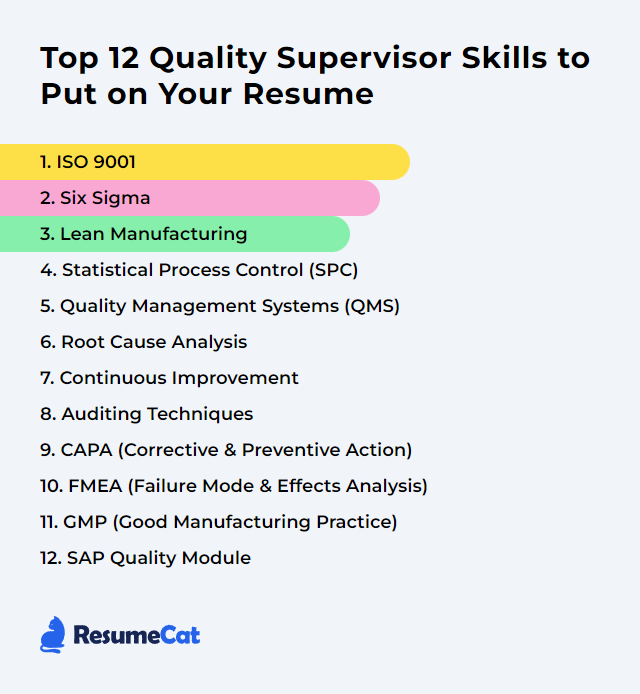Top 12 Quality Supervisor Skills to Put on Your Resume
Crafting an impressive resume is crucial for landing a position as a Quality Supervisor, and highlighting your top skills is key to standing out. This guide breaks down twelve skills that signal real command of quality, process discipline, and improvement momentum—proof you can drive consistency, compliance, and better outcomes while keeping teams aligned and customers happy.
Quality Supervisor Skills
- ISO 9001
- Six Sigma
- Lean Manufacturing
- Statistical Process Control (SPC)
- Quality Management Systems (QMS)
- Root Cause Analysis
- Continuous Improvement
- Auditing Techniques
- CAPA (Corrective and Preventive Action)
- FMEA (Failure Mode and Effects Analysis)
- GMP (Good Manufacturing Practice)
- SAP Quality Module
1. ISO 9001
ISO 9001 sets the requirements for a quality management system that consistently delivers products and services meeting customer and regulatory needs, with continuous improvement baked in. For a Quality Supervisor, it’s the blueprint for building reliable processes, disciplined documentation, and measurable outcomes.
Why It's Important
It anchors consistency, drives customer satisfaction, and gives you a framework to measure, review, and improve. You get fewer surprises. Better handoffs. Fewer defects. More trust.
How to Improve ISO 9001 Skills
Strengthen ISO 9001 capability by tightening fundamentals and keeping the system alive, not static.
Secure leadership ownership: Align objectives, resources, and reviews so quality targets are business targets.
Deepen employee involvement: Train broadly, invite feedback, recognize improvement ideas, close the loop.
Use the process approach: Map flows, define inputs/outputs, assign owners, monitor key measures.
Manage risk and opportunity: Identify, rank, and treat risks; pursue improvements with clear criteria.
Stay customer-focused: Gather feedback, analyze complaints, translate voice-of-customer into specs and controls.
Drive true continual improvement: Plan audits, run management reviews, verify effectiveness of corrective actions.
Leverage technology: Use digital forms, dashboards, and automated workflows to reduce errors and cycle time.
Invest in competence: Build skills in documentation, auditing, problem solving, and data analysis.
Do this well and your QMS becomes a performance engine, not a binder.
How to Display ISO 9001 Skills on Your Resume
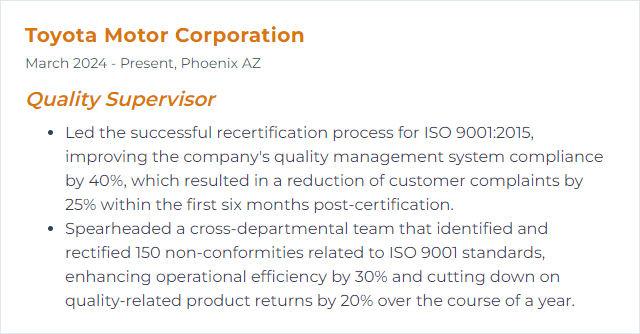
2. Six Sigma
Six Sigma is a data-first method for reducing variation and defects using structured problem solving and statistical tools.
Why It's Important
Fewer defects. Lower cost. Faster flow. It gives a Quality Supervisor rigorous methods (DMAIC/DMADV) to pinpoint root causes and lock in gains.
How to Improve Six Sigma Skills
Level up training: Refresh belts, coach project leads, and uplift basic stats literacy across teams.
Enforce DMAIC discipline: Clear problem statements, operational definitions, solid baselines, verified root causes, controlled improvements.
Make data trusted: Standardize data collection, validate measurement systems, visualize trends responsibly.
Blend Lean with Six Sigma: Remove waste and reduce variation in tandem for durable results.
Standardize sustainment: Control plans, visual management, process audits, leader standard work.
Share wins: Publish before/after metrics, lessons learned, and scalable practices.
How to Display Six Sigma Skills on Your Resume
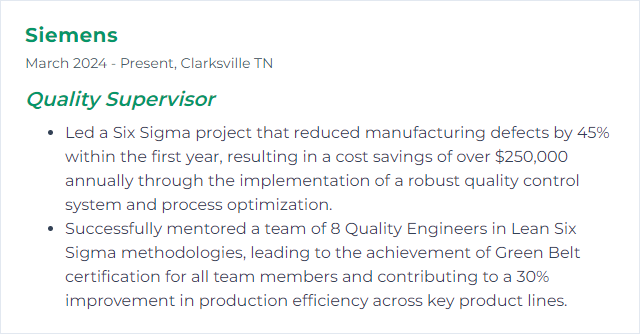
3. Lean Manufacturing
Lean Manufacturing targets waste relentlessly while protecting flow and quality. As a Quality Supervisor, it means defects are stopped at the source, processes are visual, and value moves without friction.
Why It's Important
Lean tightens cycle times, stabilizes processes, and improves quality outcomes with less rework and less chaos.
How to Improve Lean Manufacturing Skills
Run daily Kaizen: Frequent, small, team-led improvements beat occasional big projects.
Apply 5S: Sort, set in order, shine, standardize, sustain—clean space, clear mind, fewer errors.
Map the value stream: Expose bottlenecks and handoffs; cut waits, excess motion, and overprocessing.
Standardize the best way: Lock in work standards, visuals, checks, and training—then improve them.
Build problem solvers: Teach simple, fast root-cause methods; empower frontline ownership.
Listen to customers: Let critical-to-quality requirements shape takt, tests, and controls.
Upskill continuously: Cross-train, rotate roles, and strengthen flexibility.
How to Display Lean Manufacturing Skills on Your Resume
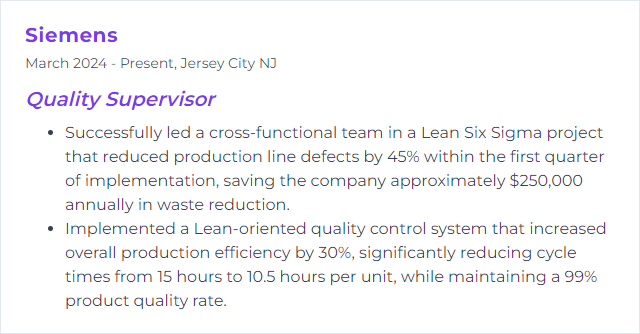
4. Statistical Process Control (SPC)
SPC monitors stability with control charts and capability metrics so you can separate noise from signal and act before defects surface.
Why It's Important
It’s your early warning system. Detect shifts, contain special causes, and maintain predictable performance with less scrap and fewer recalls.
How to Improve Statistical Process Control (SPC) Skills
Get the data right: Robust sampling plans, calibrated gauges, and verified measurement systems.
Choose the correct charts: Match charts to data types and subgroups; avoid false alarms.
Monitor in real time: Dashboards and alerts for swift containment and investigation.
Build capability knowledge: Interpret Cp, Cpk, Pp, Ppk thoughtfully; link to customer specs and risk.
Extend to suppliers: Align on specs, sampling, and reporting; prevent variation at the source.
Audit the system: Periodic reviews of rules, limits, training, and corrective action effectiveness.
How to Display Statistical Process Control (SPC) Skills on Your Resume
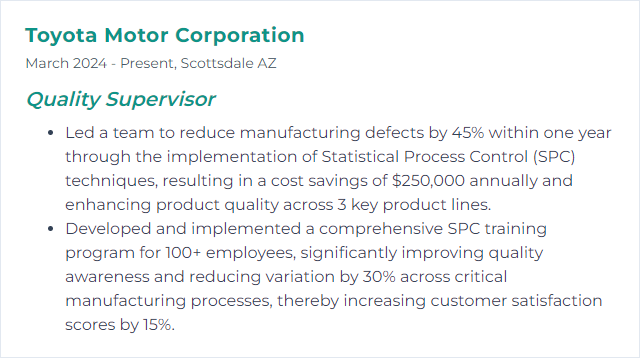
5. Quality Management Systems (QMS)
QMS structures the policies, processes, and records that ensure consistent quality and continual improvement. It’s the connective tissue between strategy and day-to-day execution.
Why It's Important
Predictable outcomes, clear responsibilities, and auditable proof. A strong QMS reduces risk and aligns teams around measurable goals.
How to Improve Quality Management Systems (QMS) Skills
Assess reality: Run gap analyses and internal audits; prioritize high-risk gaps first.
Clarify ownership: Define process owners, escalation paths, and change control rigor.
Digitize smartly: Streamline document control, training records, and action tracking with simple, reliable tools.
Engage management: Regular reviews with decisions, resourcing, and clear follow-through.
Close the loop: Tie complaints, audits, NCRs, and CAPAs into one visible system with strong verification of effectiveness.
Measure what matters: Establish meaningful KPIs and cascade them to teams with accountability.
Keep it current: Update procedures and risks promptly as processes, regulations, and customers evolve.
How to Display Quality Management Systems (QMS) Skills on Your Resume
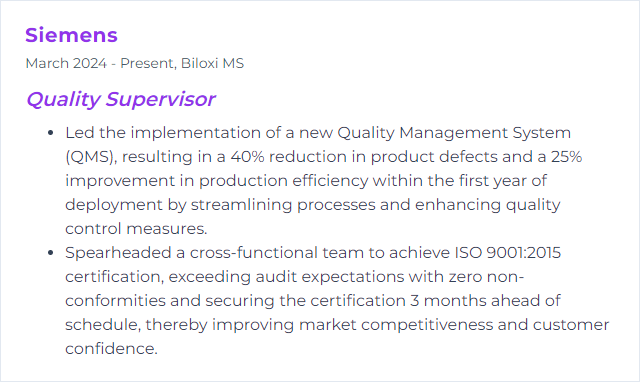
6. Root Cause Analysis
RCA is the disciplined hunt for the underlying causes of problems—so you fix what actually drives the defect, not just the symptom.
Why It's Important
Real fixes save time and money. They also prevent repeat issues, stabilize processes, and restore customer confidence.
How to Improve Root Cause Analysis Skills
Frame the problem tightly: Clear scope, facts only, operational definitions, visible impact.
Collect unbiased evidence: Process maps, timelines, checksheets, photos, voice-of-customer, and operator insights.
Use simple tools well: 5 Whys, fishbone diagrams, Pareto charts; verify with data, not hunches.
Test your theories: Run small experiments to confirm or eliminate suspected causes.
Implement targeted actions: Corrective actions that address the cause mechanism, not just containment.
Verify effectiveness: Define success criteria and monitor metrics long enough to ensure the issue stays closed.
Document and share: Build a knowledge base so teams don’t rediscover the same answers.
How to Display Root Cause Analysis Skills on Your Resume
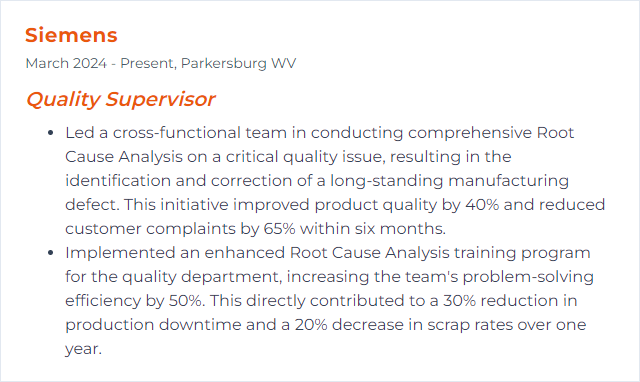
7. Continuous Improvement
Incremental gains add up. Breakthroughs happen. Continuous improvement keeps quality moving forward every week, not just during audits.
Why It's Important
It reduces waste, compresses lead times, and raises consistency. Customers feel it. Employees own it. The business benefits.
How to Improve Continuous Improvement Skills
Set sharp goals: Use clear metrics tied to safety, quality, delivery, cost, and morale.
Standardize, then improve: Stabilize current best-known methods before changing them.
Run PDCA cycles: Small tests, quick learning, faster adoption.
Make problems visible: Visual boards, tiered meetings, simple escalations.
Collect feedback constantly: From customers and frontline operators—gold for prioritization.
Benchmark and share: Compare against leaders, adopt what fits, teach others.
How to Display Continuous Improvement Skills on Your Resume
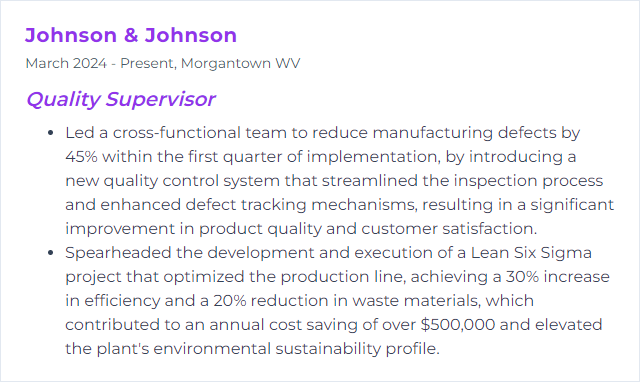
8. Auditing Techniques
Auditing evaluates whether reality matches requirements: documentation, practice, and performance. It verifies compliance and uncovers improvements.
Why It's Important
Audits protect customers and the business. They spot drift early, confirm controls, and trigger corrective action before issues spread.
How to Improve Auditing Techniques Skills
Use risk-based plans: Focus on high-risk processes, changes, and prior nonconformities.
Prepare with intent: Clear checklists, sampling plans, objective evidence expectations.
Ask better questions: Open-ended, process-focused, with follow-ups to verify effectiveness—not just existence.
Strengthen reporting: Concise findings, ranked by risk, with specific requirements and due dates.
Verify effectiveness: Re-audits and performance checks, not just documentation review.
Calibrate auditors: Train, shadow, and review to maintain consistency and impartiality.
How to Display Auditing Techniques Skills on Your Resume

9. CAPA (Corrective and Preventive Action)
CAPA finds causes, fixes them, and prevents recurrence. It ties issues to data, actions to owners, and outcomes to proof.
Why It's Important
It’s the backbone of sustained improvement and regulatory confidence. Strong CAPA reduces repeat issues and elevates reliability.
How to Improve CAPA (Corrective and Preventive Action) Skills
Define precisely: Problem statements with facts, scope, and impact; confirmed root causes.
Prioritize by risk: Rank using severity, occurrence, and detectability; act where it matters most.
Plan with clarity: Specific actions, owners, deadlines, resources, and measured outcomes.
Execute and document: Track progress visibly and maintain clean records.
Verify effectiveness: Predefine acceptance criteria; check process behavior and metrics after closure.
Prevent proactively: Trend issues, address systemic causes, and update procedures, training, and controls.
How to Display CAPA (Corrective and Preventive Action) Skills on Your Resume
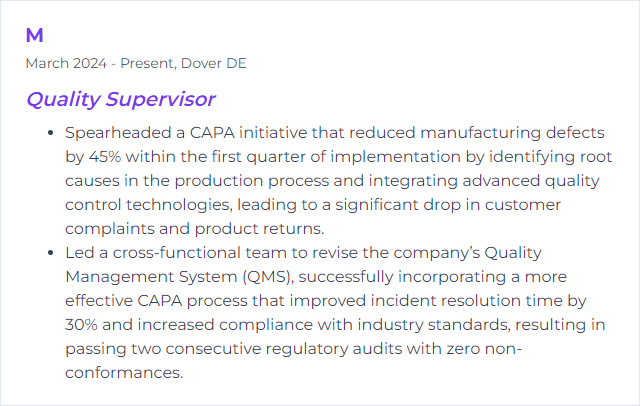
10. FMEA (Failure Mode and Effects Analysis)
FMEA proactively identifies how a process or product could fail, what the impact would be, and which controls can reduce risk to acceptable levels.
Why It's Important
It spots vulnerabilities before customers do. It prioritizes actions and strengthens prevention, detection, and response.
How to Improve FMEA (Failure Mode and Effects Analysis) Skills
Build cross-functional teams: Design, manufacturing, quality, maintenance, and supply chain—diverse eyes catch more risk.
Follow current guidance: Use the AIAG-VDA approach with Action Priority (AP) rather than relying solely on legacy RPN.
Link to real data: Feed FMEAs with field returns, SPC trends, complaints, and audit findings.
Tie actions to controls: Strengthen prevention first, then detection; document owners and due dates.
Keep it living: Update after design changes, process shifts, supplier changes, or significant incidents. Consider FMEA-MSR for monitoring and system response where applicable.
Integrate with CAPA and APQP: Ensure risks drive requirements, plans, and verifications across the lifecycle.
How to Display FMEA (Failure Mode and Effects Analysis) Skills on Your Resume
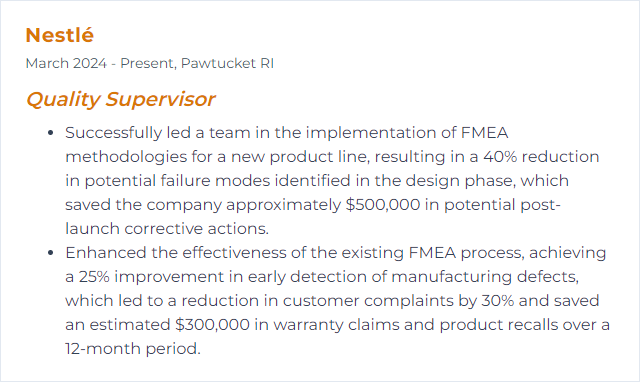
11. GMP (Good Manufacturing Practice)
GMP is the set of principles and controls that ensure products are consistently produced and controlled to quality standards across regulated industries—pharmaceuticals, medical devices, food, cosmetics, and more.
Why It's Important
It protects patients and consumers, secures compliance, and reduces costly failures by embedding rigor in people, processes, facilities, and documentation.
How to Improve GMP (Good Manufacturing Practice) Skills
Train with purpose: Role-specific, scenario-based training; frequent refreshers; verify understanding.
Tighten documentation: Clear SOPs, controlled records, validated templates, strict change control.
Audit routinely: Internal inspections that probe data integrity, aseptic/cleanliness practices, and deviation handling.
Strengthen QC/QA systems: Calibrated equipment, validated methods, robust in-process controls, and release criteria.
Qualify suppliers: Risk-based approvals, ongoing monitoring, and periodic on-site or remote assessments.
Promote continuous improvement: Trend deviations, complaints, and OOS; implement CAPA and verify effectiveness.
How to Display GMP (Good Manufacturing Practice) Skills on Your Resume
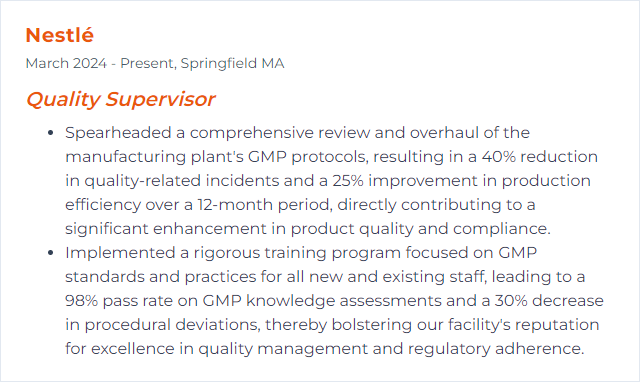
12. SAP Quality Module
The SAP Quality Management (QM) module—available in SAP ERP and S/4HANA—supports inspection planning, quality notifications, inspection lots, results recording, usage decisions, audit management, and integration across MM, PP, and SD.
Why It's Important
It centralizes quality data and workflows, tightens traceability, and connects quality actions to materials, batches, suppliers, production, and shipments.
How to Improve SAP Quality Module Skills
Master core objects: Inspection plans, characteristics, sampling procedures, catalogs, and notifications.
Customize thoughtfully: Tailor catalogs, codes, usage decisions, and status profiles to reflect your processes and controls.
Integrate end-to-end: Align QM with MM for incoming inspections, PP for in-process checks, and SD for delivery releases and customer complaints.
Automate insights: Build dashboards and alerts for trends in defects, suppliers, batches, and process steps.
Train super users: Create internal experts who support, troubleshoot, and coach others.
Iterate continuously: Review master data quality, simplify screens, refine workflows, and retire unused codes.
How to Display SAP Quality Module Skills on Your Resume
